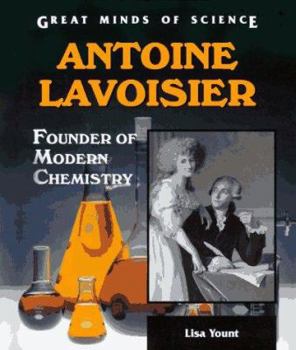Antoine Lavoisier: Founder of Modern Chemistry
(Part of the Great Minds of Science Series)
Select Format
Select Condition 
Book Overview
Antoine Lavoisier was the groundbreaking French scientist who explored the nature of combustion and gave a name to the gas, oxygen. His systematic experiments and important discoveries, especially in... This description may be from another edition of this product.
Format:Library Binding
Language:English
ISBN:0894907859
ISBN13:9780894907852
Release Date:January 1997
Publisher:Enslow Publishers
Length:128 Pages
Weight:1.15 lbs.
Dimensions:0.5" x 7.9" x 9.3"
Age Range:9 to 15 years
Grade Range:Grades 4 to 10
Customer Reviews
1 rating
Smoothly written. Smooth to read. Successfully integrates science, personalities, and history.
Published by Thriftbooks.com User , 15 years ago
The book contains 128 pages, with 20 black and white illustrations, and one map of Europe, with an emphasis on France (I love maps). The pages are semi-glossy, and the reproductions are quite good (not blurry), with good contrast. The author starts by setting up an inviting context, namely that recipes for cooking cakes use ingredients and steps in the same way that procedures in chemistry use ingredients and steps. Then, the book touches on the scientific problems facing chemists at the time, e.g., inability to make any predictions in chemistry due to lack of knowledge of constituents of chemical compounds, and due to inconsistent naming of various chemical compounds. Three pages are spent on Lavoisier's childhood and schooling (pages 14-16). His first discovery is disclosed as the dehydration and rehydration of gypsum (plaster). His second accomplishment was a cost/benefit analysis of street lamps, comparing oils and candles (pages 18-19). We also learn about Lavoisier's wife, Marie Anne, who translated English chemistry papers into French, and illustrated Lavoisier's books. Also, there is a reproduction of Jacques Louis David's oil painting of Lavoisier with Marie. Lisa Yount is careful to include bits of local color here and there. In describing a geology trip with Jean Guettard, she writes, "One night he and Guettard had to sleep in a smelly barn filled with onions." More local color occurs in a 3-page narrative on mesmerism (pages 62): "Music played in the background. People sat around a tub full of bottles of water that was supposed to be magnetized. They all held hands. Iron rods stuck out of the tub. Mesmer's assistant moved a wand over the people." The relevance is that Lavoisier was part of a group, which included Benjamin Franklin, that investigated fraud, and make reports about the fraud to the Academy of Sciences. The author's writing tracks the times. She is careful to disclose examples of government abuses that led to the French Revolution, e.g., Tax Farms(pages 20, 21, 24, 52, 53). For those interested in the French Revolution, I recommend Jeremy Popkin's A SHORT HISTORY OF THE FRENCH REVOLUTION, and Simon Schama's CITIZENS A CHRONICLE OF THE FRENCH REVOLUTION. The author then turns our attention to more discoveries, namely, Lavoisier's discovery that burning involves the combination of something from air (oxygen) with the burned substance, for example, carbon, phosphorus, or sulfur. Lavoisier discovered that, with burning, the product (sulfuric acid) has more weight than the starting material (sulfur). In another experiment involving heating, Lavoisier heated mercury in a sealed vessel, and found that 1/6th of the air disappeared, where the residual air (nitrogen) had the property of extinguishing candles or mice. Conversely, Lavoisier discovered that heating the heated mercury, could release a gas (oxygen) that could support candles, could combine with phosphorus to create phosphoric acid, and could be u




